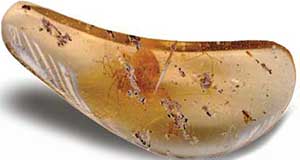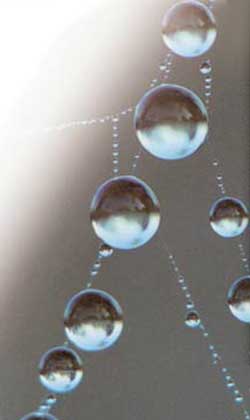Bigotry: The Dark Danger
A Definitive Reply to Evolutionist Propaganda

DOWNLOAD THE BOOK
CHAPTERS OF THE BOOK
- Introduction
- A Series of Blunders Regarding Monkey Intelligence
- The Smuggling Incident National Geographic TV Declined To Cover
- National Geographic TV's Undersea Fairy Tales
- Tall Tales From The National Geographic Channel
- Tales of Transformation from National Geographic Television
- The “Mitochondrial Eve” Deception On The Discovery Channel
- The Dino-Bird Fantasy On The Discovery Channel
- Errors Concerning Human Intelligence From The Discovery Channel
- The Discovery Channel's Spider Dilemma
- Evolutionst Propaganda on The History Channel
- The History Channel's Darwinist and Atheist Propaganda
- New Scientist’s Latest Myth:"Hiccups are a Legacy from Evolution"
- New Scientist’s “ Evolution with Climate” Error
- Paul Davies' Desperate Case for a “Multiverse”
- Evolutionary Tall Tales From The BBC -I-
- Evolutionary Tall Tales From The BBC –II-
- Evolutionary Tall Tales From The BBC –III-
- The BBC's Functionless Tissue Error In Its Documentary The Human Body
- BBC's Evolution of The Human Brain Error
- The Evolutionist Deceptions in the Documentary the Shape of Life
- Evolutionist Deceptions Continue with the Arthropods in the Shape of Life Documentary
- The Evolutionists are Still Struggling with the Same Dilemma: The Origin of Flight
- New Fossil Fish Discoveries Pose a New Dilemma for the Theory of Evolution
- The Latest Version of Baseless Evolutionist Scenarios in Scientific American: Nutrition
- Time Writer M. Lemonick's Mind-Body Error
< <
10 / total: 26
The Discovery Channel's Spider Dilemma
The Discovery Channel recently broadcast a documentary called Discovery Journal: The Spider. The documentary gives examples of the hunting techniques employed by various species of spider and stresses what a superior substance spider thread is. It describes how spider thread is much stronger than steel, and mentions the technological and industrial fields in which this material could be used once it has been artificially replicated. The channel produced a most entertaining programme with its close-ups of spiders and their webs. Yet, when it came to the origin of spiders, The Discovery Channel made a comment that at once cast a shadow over its scientific credentials, saying, "It is by no means easy to imitate this material, which is the product of 380 million years of evolution." The evidence put forward on the channel for this claim consisted solely of statements by a scientist who discovered 380-million-year-old fossilized spinneret (the organ at the rear of the spider from which it produces its thread). This scientist claimed that he had found the distant ancestors of spiders, and said that when he dissolved 380-million-year-old rocks and examined them under the microscope he had identified the spinneret inside them. Yet, there was absolutely no proof that these spinnerets belonged to "spiders' distant ancestors," and not a real spider. The spinnerets display absolutely no intermediate form characteristics, and no difference has been found between them and those of modern spiders.
The Discovery Channel's portrayal of this fossil as spiders' distant ancestor is nothing more than a deception. That is because the scientific world has known for some 20 years that there is no difference between 380-million-year-old spiders and present-day ones. At its annual conference in 1983, the American Association for the Advancement of Science put forward important fossil discoveries regarding these creatures. The interesting thing about these 380-million-year-old fossils of spiders, ticks, and centipedes is that they are no different from their modern counterparts. One of the scientists who examined the fossils remarked that "they looked like they might have died yesterday."1 It is stated on the Australian Museum website that 380-million-year-old examples of the spider Attercopus fimbriungus possessed silk-producing organs even then.2 These fossils reflect the origin of spiders in the most realistic manner and invalidate The Discovery Channel's claims: Spiders emerged not by evolution, but suddenly and perfectly formed, and have undergone no change in the millions of years that have followed.
On the other hand, it also shows that the evolutionist interpretations of spider silk and the complex features of their webs are utterly forced. For instance, spider thread is so light that one kilogram of it could stretch around the earth three times. Despite being so light, spider thread is five times stronger than steel of the same weight. Thanks to its elasticity, it can stretch up to four times its own length. All of this is made possible by the special structure and arrangement of the atoms which make up spider thread. Moreover, although spider silk is solid in web form, it is a liquid in the spider's body. As soon it makes contact with the air, it solidifies as the result of a rapid reaction. Yet, spider thread, which is "the envy of chemists and materials scientists everywhere," as one American newspaper put it, can also revert to its original form.3 By eating its own web, the spider can turn it back into liquid form for re-use later. Alongside this web-production, web-weaving is also a complex behavior. Although the spider's brain is no larger than a grain of salt, an architectural plan can be seen in the web it spins. The spider drops its thread down from where it sits and waits for the wind to carry it somewhere it can stick to. It then sticks the other end of the thread to another suitable point. After having drawn a few diagonal struts in this way, it starts to fill in the gaps between them with circular links. Anything coming into contact with the web is swiftly immobilised. Yet, the spider itself is unaffected by the adhesive nature of its web.
In other words, for the spider to have come about by evolution, both the web with its exceedingly complex biochemical structure, and the complex behavior allowing the spider to make use of the web, would have to have come about by means of chance mutations. It is clear that this is impossible. Moreover, there is absolutely no experimental, observational, or fossil evidence to support this evolutionist claim. On the contrary, the evidence deals a mortal blow to evolution: the fact that 380-million-year-old spider fossils are no different from modern spiders, and the complex structure of the web, pose insuperable difficulties for evolutionists. Given these difficulties, The Discovery Channel declines to touch on the subject of how an organ that produces a substance with such superior properties, which scientists are trying to imitate, could have evolved by chance mutations. It therefore resorts to familiar old stories. The channel starts off with the shape of the nest, which spiders erected between plants on the ground and which contained a downward-pointing funnel: "These nests in the shape of funnels turned into a silken layer as the spiders climbed up on the trees. The gradually developing layer turned sideways, took shape and the circular web formed." The Discovery Channel may imagine that with this story it has overcome the problem of the origin of spiders. If so, it is mistaken, because the web it places at the beginning of its story must have been made of spider thread with a flawless structure. Since it offers no proof that webs close to the ground are ancient in evolutionary terms, whereas those high up are more recent, it places spider webs in an imaginary chronological framework. ConclusionThe Discovery Channel's ideas regarding the origin of spiders are nothing more than an expression of its terrible quandary on the subject. The true origin of the spider and its web, which place the channel in such difficulties, is creation. It is God, the Lord of the Worlds, the Lord of Infinite Knowledge and Might, Who creates the spider and its web-producing system, and Who inspires it to spin its webs. No matter how hard they may try, evolutionists can no longer conceal this evident truth.
Footnotes1. San Diego Union, New York Times Press Service, 29 May 1983; W. A. Shear, Science, vol. 224, 1984, p. 494 2. Australian Museum Online, 2002 http://www.amonline.net.au/spiders/diversity/what/origins.htm 3. Stephen Reucroft and John Swain, "Spider silk mystery solved," Boston Globe, 10/22/2002
|
10 / total 26
You can read Harun Yahya's book A Definitive Reply to Evolutionist Propaganda online, share it on social networks such as Facebook and Twitter, download it to your computer, use it in your homework and theses, and publish, copy or reproduce it on your own web sites or blogs without paying any copyright fee, so long as you acknowledge this site as the reference.



